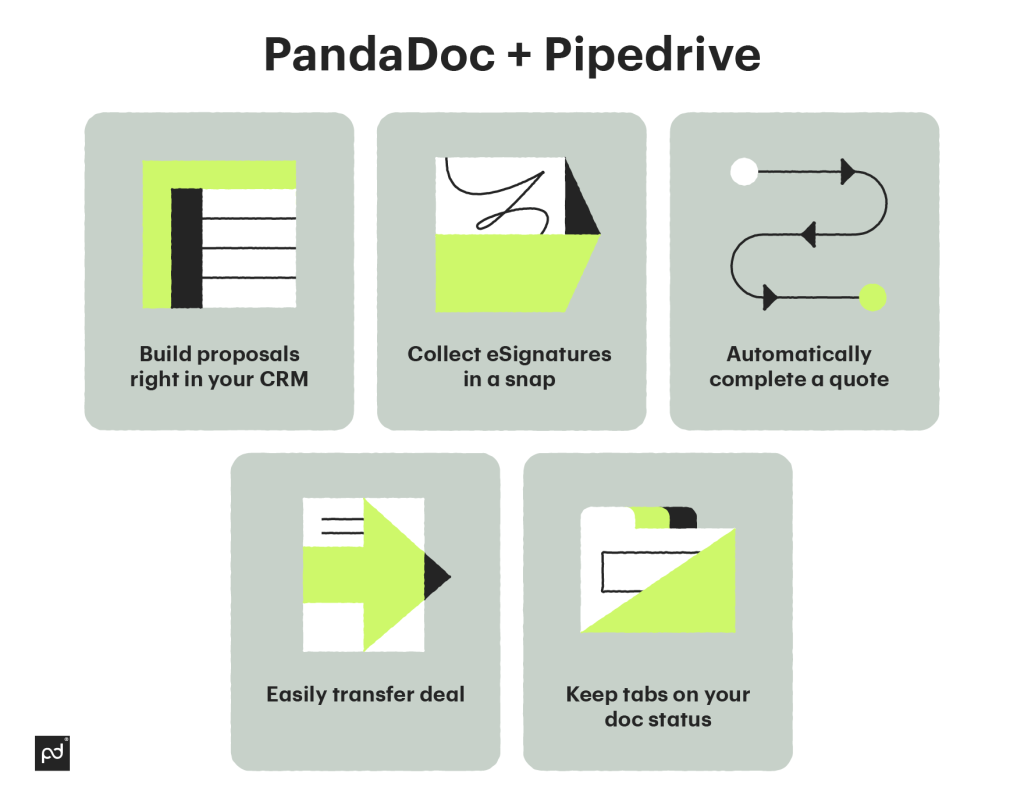CRM, short for customer relationship management, is an approach to managing customer data that helps you maintain close relationships and drive better results. Having the right CRM software is essential to achieve this.
The right CRM puts your customers first, streamlines collaboration, and provides a single source of truth, updated in real-time. It also enables a seamless omnichannel experience, crucial for sales.
McKinsey & Company says B2B customers use 10 or more channels to communicate and make a purchase.
As customer relationships grow, spreadsheets become limiting. A comprehensive cloud CRM solution is needed to manage complex, dynamic data.
This article will explore CRM software’s benefits, including strong customer relationships, improved collaboration, and faster deal closing with tools like PandaDoc.
What is CRM software — and do you need one?
CRM software is your one-stop-shop for all customer data, helping your team work together smoothly, build lasting customer relationships, pinpoint sales opportunities, and deliver an unbeatable customer experience.
The key to CRM? It’s all about shifting from transactions to relationships, putting your customers smack dab in the middle of your business. And guess what? Businesses that are all about their customers are 60% more profitable than those that aren’t.
With the right CRM tool, you’re not just managing individual customer interactions – you’re streamlining the entire customer journey. This boosts customer satisfaction and loyalty big time.
And let’s not forget about omnichannel sales. Customers are using different channels to research, communicate, and buy. To keep up, you need a powerful tool to manage real-time data. That’s where CRM comes in.
The best part? Companies focusing on the whole customer journey rather than individual touchpoints see customer satisfaction shoot up by up to 117%, and customers are up to 104% more willing to recommend the business to others.
Ready to level up with CRM? Whether you’re managing hundreds or thousands of customer relationships, CRM can help you:
- Manage complex, long-term relationships across different channels
- Automate tedious tasks and boost team collaboration
- Personalize messaging at scale for a tailor-made customer service
- Access all customer data in real-time, spotting key growth opportunities
- Reduce customer churn and keep subscription renewals steady (especially for subscription businesses like SaaS companies)
- Plus, CRM platforms are cloud-based, making them super scalable and adaptable for any business size
Put your customers first, work seamlessly with all teams, and manage complex customer data
Let’s look at all the main benefits of CRM software to see how it can help you achieve more and drive the results.
1. Redefine how you manage your customer relationships
Relationship selling is more efficient than traditional sales approaches, and CRM helps highlight that objective: building and enhancing relationships. In the traditional sales approach, a sales rep makes a pitch and addresses objections. The relationship usually ends with or without a sale.
Relationship selling means consistently prioritizing customers’ needs and creating meaningful relationships based on understanding and providing value beyond the sale. CRM software enables building and managing these relationships at scale without relying on Excel sheets or memory.
With the right CRM, you can consistently provide excellent service by checking customer data before each interaction and understanding their needs and past objections.
2. Have a global overview by connecting data from all your systems
By integrating the right tools, you can gather all your data in one place and ensure it flows effortlessly across all the apps you use.
Looking at each relationship’s timeline and key interactions helps you deepen connections with your customers and offer a personalized service tailored to their needs.
At a broader level, having data on all your customer relationships lets you spot:
- Relationships with great potential that haven’t fully blossomed yet. You can then reach out to these customers to deepen the relationship and take it to the next stage.
- Problems that could cause relationships to go south, dealing with them before they lead to customer churn.
- Nearly sealed deals where an extra call might be the push your lead needs to convert.
- Chances to reignite relationships with inactive customers, checking in with them to ensure they have all the info they need to maximize their subscription.
If you connect your CRM with PandaDoc, you can handle all contracts and proposals right from your CRM and instantly see the status of each document waiting for a signature.
3. Shorten the sales cycle
If you want to shorten your sales cycle, you have to keep in touch with your hottest leads often. Don’t let them go cold and run off to your competitors. And don’t forget those lukewarm leads that still have some potential to convert.
Another cool thing about CRM tools? They let you clean up your lists of cold leads regularly. So, you can redirect your time and effort towards leads with more potential.
And if you really want to shorten your sales cycle with a CRM, make it super easy for your leads to sign contracts, no matter what device or channel they’re using.
Doing this is a breeze with a CRM and PandaDoc. Our solution lets you whip up and send proposals and contracts in minutes. With your CRM, you can autofill documents and track their progress in real time. How cool is that?
3. Use a personalized approach at scale
With automation, you can tailor your messages to a T, even when you’re doing it on a large scale.
Handling recurring interactions becomes a breeze with a CRM tool. Plus, having all your customer data handy always makes it way easier to customize your message.
Sure, email is a great way to tailor your messaging, but it can also suck up a lot of a salesperson’s time. Did you know reps spend 28% of their workdays penning or replying to emails?
That’s where a CRM platform comes in. It keeps all important info in one place, automates personalization and follow-ups, and lets you track all interactions.
If you want to personalize interactions while staying efficient, automation is your best bet. And that’s exactly what most CRM systems offer. They help you automate those repetitive tasks, search for data, and use it in the best way possible to provide a custom sales experience.
But for CRM automation to hit the mark, you’ve got to make sure all your tech tools are well-connected with the right integrations. That way, your data can flow smoothly from one tool to another.
4. Measure the ROI of sales, marketing, and customer support
Your CRM software is like a crossroads where sales, marketing, and customer support meet. It’s what lets you easily figure out the ROI for any initiatives from these departments.
Most CRM tools are packed with top-notch reporting and analytics features. They help you follow each customer’s journey from start to finish. You get to see how the lead came about (thanks to marketing), what made them convert (that’s your sales team), and how they interacted with customer support before and after converting (props to customer support).
This way, you can look at the ROI of each team’s efforts and spot and build on successful initiatives and approaches.
Plus, you can make informed decisions about sales quotas, tailor your outreach tactics to what your audience likes — and gear them toward what works best for them.
How can different business units use CRM software to their advantage?
Each department or business unit will likely use CRM software differently and with a different goal.
This flexibility is not a problem — on the contrary, it’s one of the core benefits of CRM platforms.
Management can have a global overview of customer data & relationships
To identify the best strategic opportunities for growth, you need to look at your customer data in its entirety and have access to actionable insights.
Most companies understand this: 93% plan to continue increasing data analytics investments.
CRM platforms collect and aggregate data from different sources, giving you a complete overview of your customer base and sales pipeline.
The sales team can manage communication with leads more efficiently — and close deals faster
CRM platforms are an invaluable tool for sales development representatives (SDRs), as they enable them to:
- Maintain many relationships at once
- Streamline the decision-making process
- Automate follow-ups and regular check-ins
- Personalize their messages
- Adapt their approach to each customer’s preferences and needs
- See which strategies work best — and which ones don’t
- Close deals faster
For the last point, using a comprehensive contract management tool like PandaDoc is crucial, as it enables the sales team to prepare and send contracts at a fraction of the time they’d otherwise need — and also makes it super easy for leads to sign.
Legal can have a full overview of all contracts
CRM and legal are not often discussed together, but that’s a mistake: your CRM platform can also be a valuable asset for your legal department and serve as a point of reference for all contract information with your customers, allowing the legal team to access it easily whenever necessary.
If your CRM software is integrated with PandaDoc, your legal department can simply pull all contracts your company has with clients and review them whenever they need to double-check something, review the contract of a long-term client, or compare contracts.
Customer support can tailor its efforts to the needs of individual customers
CRM apps also empower your customer support team by giving it access to all the information they need to understand better serve customers.
With the help of a CRM platform, customer support can easily check past interactions of the client, their purchase history, and any notes other team members might have added to their profile.
This can also help you address issues before they become problems and ensure customers know how to make the most of each service or product they’ve purchased.
Customer success teams can plan and execute new initiatives
In addition to the above, CRM enables customer success teams to create and develop new initiatives and measure outcomes.
Customer success teams work at the intersection of sales and customer support, helping customers make the most of each purchase and moving them to the next step in your sales pipeline, either by upselling or cross-selling other products or services.
For this, they need a CRM to obtain detailed, up-to-date customer information, including past interactions, purchases, and preferences — this allows teams to scale their efforts, use new approaches, and design new customer success initiatives.
What is the best CRM tool to streamline customer relationships?
Many CRM tools are on the market, tailored to different businesses’ priorities, processes, and needs.
When exploring different options, there are many factors to consider. We advise you to look into the following when evaluating each platform:
- Usability: Is the platform easy to use or has a steep learning curve?
- Level of automation: Can the platform help you automate and simplify your processes?
- Customization features: Can the CRM system adapt to the needs and functioning of your business?
- Integration capabilities: Can your CRM connect effortlessly to the rest of your technology stack?
- Reporting and analytics: Does it have powerful reporting and data analysis capabilities?
We have many opinions, but we believe Pipedrive would be an excellent choice as a CRM. Pipedrive is popular due to its extensive experience supporting early-stage startups and solopreneurs.
With over 100,000 loyal corporate users globally, the CRM helps sales teams excel at their work and convert more leads. Ease of implementation and use is appealing, and pricing doesn’t bite either.
Pipedrive in a nutshell
Both mature SMBs and newly minted sales teams love Pipedrive for how newcomer-friendly the CRM is.
The no-strings-attached free trial, a couple of tutorials, and a bunch of courses allow users to set up and start tinkering with the available features successfully.
Any sales rep can drag and drop stages and figure out how to optimize the sales pipeline for a specific segment, product type, or scenario.
Reporting is another highlight with Pipedrive — a deep nomenclature of data types and filters allows one to create, analyze, and share reports with high detail.
Streamlined and easy-to-perform processes for data generation and effective ways to analyze performance appeals to small and midsize businesses.
On top of the core features, Pipedrive jives well with third-party integrations and offers several powerful add-ons, including Microsoft Power BI, Slack, and Zapier.
Upgrading your plan might be required to access those additional features fully, but as an emerging sales team with a small business, your best bet is to start with a bare-bones setup and keep building out from there on.
PandaDoc plus Pipedrive

The integration between Pipedrive and PandaDoc helps teams to align, finalize and sign documents much faster.
PandaDoc offers a suite of powerful features for easier processing of your documents, including:
- Quickly build up and create fully personalized documents
- Share and track changes in documents without leaving Pipedrive
- Align and implement changes with ease, working cross-company and with cross-functionality
- Deep-automate your document flows, creating a better experience for your sales team and leads
Pave the way to better customer relationship management with the right CRM system
At its core, CRM software is all about helping businesses take on a customer-focused approach to sales and handle complex relationships like a pro.
It also helps you shift from handling individual touchpoints to smoothing out the entire customer journey from start to finish. This lets you give your customers more bang for their buck and drive the best business results.
If you want to get the most out of your CRM system, you’ve got to weave it into the rest of your tech stack. With the right integrations and workflows, you can beef up your CRM tools to handle document management, sales forecasting, knowledge base management, project management, and more.


